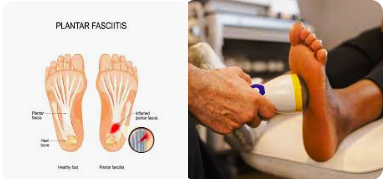If you are struggling with chronic heel pain and wondering whether SoftWave therapy for plantar fasciitis can help, the short answer is yes—SoftWave therapy is one of the most effective non-invasive treatments for plantar fasciitis relief.
In this article, we will explore what SoftWave therapy is, how it works for plantar fasciitis, its benefits, treatment process, success rate, and how it compares to other therapies. By the end, you’ll have a complete understanding of why more podiatrists and physical therapists are recommending it for patients with stubborn heel pain.
Table of Contents
What is Plantar Fasciitis?
Plantar fasciitis is one of the most common causes of heel pain, affecting athletes, runners, and even people who stand long hours at work. It occurs when the plantar fascia, a thick band of tissue connecting the heel bone to the toes, becomes inflamed or develops microtears.
Key symptoms include:
- Sharp heel pain, especially in the morning (first-step pain)
- Pain after prolonged standing or walking
- Heel stiffness and tenderness
- Discomfort that worsens after exercise
Traditional treatments like rest, stretching, orthotics, night splints, NSAIDs, and steroid injections don’t always provide lasting relief. This is where SoftWave therapy comes in.
What is SoftWave Therapy?
SoftWave therapy, also known as SoftWave TRT (Tissue Regeneration Technology), is a non-invasive regenerative medicine treatment that uses electrohydraulic shockwaves to stimulate the body’s natural healing response.
Unlike traditional treatments that simply mask pain, SoftWave targets the root cause by:
- Increasing blood flow to the plantar fascia
- Reducing inflammation and scar tissue
- Activating stem cells for faster tissue repair
- Breaking down calcifications that worsen heel pain
How Does SoftWave Therapy Help Plantar Fasciitis?
When applied to the heel, SoftWave therapy delivers low-intensity shockwaves that penetrate deep into the damaged plantar fascia.
This process:
- Stimulates tissue regeneration – activates dormant stem cells and growth factors.
- Promotes angiogenesis – creates new blood vessels for better circulation.
- Reduces inflammation – calms down chronic irritation of the fascia.
- Breaks up adhesions – loosens scar tissue and tight fascia fibers.
- Provides long-term pain relief – addresses the root cause, not just symptoms.
Many patients report improvement after the first session, with significant reduction in pain after 3–6 treatments.
Benefits of SoftWave Therapy for Plantar Fasciitis
SoftWave therapy has several unique advantages over traditional treatments:
✅ Non-invasive & drug-free – No surgery or injections.
✅ Quick sessions – Treatments last 10–15 minutes.
✅ Minimal downtime – Patients can walk immediately after therapy.
✅ Long-lasting results – Unlike cortisone shots, relief is not temporary.
✅ FDA-cleared technology – Backed by scientific research and clinical use.
✅ High success rate – Studies show significant improvement in plantar fasciitis patients.
Treatment Process: What to Expect
A typical SoftWave therapy for plantar fasciitis session looks like this:
- Evaluation – The provider locates the most painful areas on the heel.
- Application – A handheld SoftWave device is applied to the heel and plantar fascia.
- Shockwave delivery – Pulses are delivered for 10–15 minutes.
- Post-session mobility – Patients can resume walking and daily activities immediately.
👉 Most patients require 3–6 sessions spaced weekly for optimal results.
SoftWave Therapy vs Other Plantar Fasciitis Treatments
| Treatment | Invasiveness | Pain Relief Duration | Healing Approach |
|---|---|---|---|
| Rest & Stretching | None | Temporary | Symptom management only |
| NSAIDs / Cortisone | Mild (injection) | Weeks to months | Reduces inflammation but no healing |
| Orthotics & Night Splints | None | Symptom relief | Supports fascia, no regeneration |
| Surgery | High | Permanent (but risky) | Removes fascia, long recovery |
| SoftWave Therapy | Non-invasive | Long-term | Regenerates tissue & reduces pain |
Clearly, SoftWave therapy bridges the gap—offering healing without the risks of surgery or temporary relief from medication.
Who is a Good Candidate for SoftWave Therapy?
You may benefit from SoftWave therapy for plantar fasciitis if you:
- Have had heel pain for more than 3 months
- Tried stretching, orthotics, or medications without success
- Want to avoid steroid injections or surgery
- Are an athlete or active individual needing quick recovery
- Experience chronic morning heel pain that affects daily life
Potential Side Effects and Risks
SoftWave therapy is generally safe and well-tolerated. Some patients may experience:
- Mild redness at the treatment site
- Temporary soreness (like post-workout stiffness)
- Slight tingling sensation during treatment
These effects usually resolve within 24–48 hours.
Patient Results and Success Rate
Clinical studies and patient testimonials show that over 80% of plantar fasciitis patients experience significant improvement with SoftWave therapy.
- Many patients notice relief after the first session.
- Full benefits are usually achieved after 3–6 treatments.
- Pain relief is long-lasting because the therapy stimulates true healing, not just masking symptoms.
FAQs on SoftWave Therapy for Plantar Fasciitis
1. What is SoftWave therapy for plantar fasciitis?
SoftWave therapy is a non-invasive shockwave treatment that uses acoustic waves to stimulate healing in the heel and fascia tissue. It helps reduce inflammation, improve blood circulation, and speed up natural recovery without surgery or injections.
2. How does SoftWave therapy relieve heel pain?
The therapy works by sending low-intensity shockwaves into the plantar fascia. These waves trigger cell regeneration, collagen production, and improved blood flow, which ease chronic heel pain and restore mobility.
3. Is SoftWave therapy safe for plantar fasciitis?
Yes, SoftWave therapy is FDA-cleared and clinically tested. It is considered safe, non-invasive, and effective for treating plantar fasciitis, heel spurs, and chronic foot pain. Most patients experience little to no side effects beyond mild soreness after treatment.
4. How many SoftWave therapy sessions are needed for plantar fasciitis?
Most patients require 6–8 sessions, depending on the severity of the condition. Some notice relief after the first or second treatment, while chronic cases may need more sessions for long-term results.
5. What are the benefits of SoftWave therapy compared to traditional treatments?
- No downtime or surgery required
- Promotes natural tissue healing
- Reduces reliance on painkillers or steroid injections
- Effective for chronic plantar fasciitis and heel pain
- Improves long-term mobility and quality of life
6. How long does it take to feel results from SoftWave therapy?
Patients often report pain relief within days of the first session. For lasting results, the full treatment plan is recommended since SoftWave encourages long-term tissue repair.
7. Can SoftWave therapy help with heel spurs as well?
Yes. Since heel spurs often occur with plantar fasciitis, SoftWave therapy can reduce calcification, inflammation, and fascia stiffness, making it effective for both conditions.
8. Who is a good candidate for SoftWave therapy?
SoftWave therapy is suitable for people who:
- Suffer from chronic plantar fasciitis
- Did not respond to physical therapy or orthotics
- Want a non-surgical alternative for heel pain
- Experience recurring foot pain from standing or walking
9. Are there any side effects of SoftWave therapy?
Side effects are minimal. Patients may feel mild redness, swelling, or soreness at the treatment site, but these symptoms usually subside within 24–48 hours.
10. How much does SoftWave therapy for plantar fasciitis cost?
The cost varies depending on the clinic and location, but most treatment packages range between $300–$600 per session. Some providers offer discounted bundles for multiple sessions.
Final Thoughts
SoftWave therapy for plantar fasciitis is a breakthrough treatment offering non-invasive, long-lasting relief for heel pain sufferers. By targeting the root cause—damaged fascia tissue—it promotes true healing rather than just masking pain.
If you’ve tried traditional treatments without success, SoftWave therapy may be the best next step toward living pain-free and regaining your mobility.




